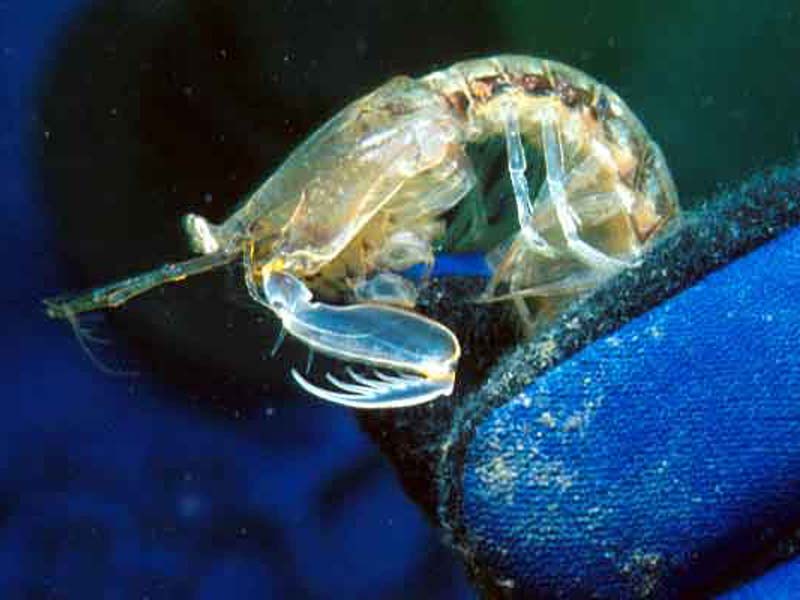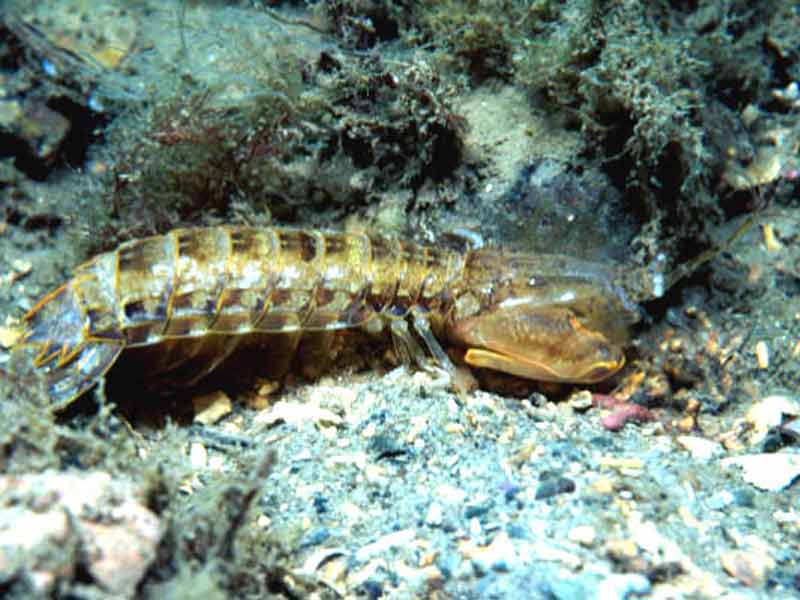A mantis shrimp (Rissoides desmaresti)
Distribution data supplied by the Ocean Biodiversity Information System (OBIS). To interrogate UK data visit the NBN Atlas.Map Help
| Researched by | Anna Neish | Refereed by | Admin |
| Authority | (Risso, 1816) | ||
| Other common names | - | Synonyms | Meiosquilla desmaresti (Risso, 1816), Squilla desmaresti (Risso, 1816) |
Summary
Description
Recorded distribution in Britain and Ireland
Small numbers of Rissoides desmaresti have been recorded on the south and west coasts of the British Isles in a few isolated places. An extensive bed of 25 hectares has recently been found in north Wales (Ramsay & Holt, 2001).Global distribution
More commonly found in the Mediterranean. Also found on the Atlantic coast of Europe and northwards to the southern British waters.Habitat
The species creates a simple burrow systems in sandy, gravely mud sediments from the lower shore down to 15 to 50 m deep. In dense distributions 1 burrow per m² can be found. The burrows are a elongated U-shape with only 2 openings, one wider than the other.Depth range
-Identifying features
- Large shrimp found in burrows.
- Elongated body of about 10 cm.
- Large raptorial claws on second pair of thoracic legs.
- Dactylus of raptorial claw with 5 spines.
Additional information
Can be distinguished from Platysquilla eusebia, the only other British mantis shrimp species, by the number of spines on the dactylus of the raptorial claw. Rissoides desmaresti has 5 spines and Platysquilla eusebia has 12-15 spines. Occasionally catches of Rissoides desmaresti sometimes generates press coverage and suggestions of global warming. The species has been recorded in the Plymouth area since 1900 including intertidally in Salcombe harbour (MBA, 1957).Listed by
- none -
Bibliography
Holt, R.H.F., 1999. Crustaceans: Mantis Shrimp Rissoides desmaresti http://ourworld.compuserve.com/homepages/BMLSS/Mantis.htm, 2002-12-04
Howson, C.M. & Picton, B.E., 1997. The species directory of the marine fauna and flora of the British Isles and surrounding seas. Belfast: Ulster Museum. [Ulster Museum publication, no. 276.]
Mauchline, J., 1984. Euphausiid, Stomatopod and Leptostracan Crustaceans. Leiden, The Netherlands: E.J. Brill Publishing Company.
MBA (Marine Biological Association), 1957. Plymouth Marine Fauna. Plymouth: Marine Biological Association of the United Kingdom.
Moore, J., 2002. An atlas of marine Biodiversity Action Plan species and habitats and Species of Conservation Concern in Wales, 2nd edn. Report to the Countryside Council for Wales, CCW Contract Science Report no. 509.
Ramsay, K., & Holt, R.H.F., 2001. Mantis shrimps Rissoides desmaresti in Tremadog Bay, North Wales. Journal of the Marine Biological Association of the United Kingdom, 81, 695-696.
Datasets
Isle of Wight Local Records Centre, 2017. IOW Natural History & Archaeological Society Marine Invertebrate Records 1853- 2011. Occurrence dataset: https://doi.org/10.15468/d9amhg accessed via GBIF.org on 2018-09-27.
NBN (National Biodiversity Network) Atlas. Available from: https://www.nbnatlas.org.
OBIS (Ocean Biodiversity Information System), 2025. Global map of species distribution using gridded data. Available from: Ocean Biogeographic Information System. www.iobis.org. Accessed: 2025-07-13
Citation
This review can be cited as:
Last Updated: 26/06/2003




